Ijraset Journal For Research in Applied Science and Engineering Technology
- Home / Ijraset
- On This Page
- Abstract
- Introduction
- Conclusion
- References
- Copyright
A Study on Seismic Performance of Open Ground Storey RCC Frames Analyzed by Response Spectrum Method
Authors: Ramesh M, Dr. Chidananda G
DOI Link: https://doi.org/10.22214/ijraset.2022.47006
Certificate: View Certificate
Abstract
In the present study, seismic performance of Open Ground Storey (OGS) RCC frames is investigated using ETABS software. Bare frame, OGS frames and frames with RCC walls at ground storey are considered and infill walls are modelled as equivalent diagonal strut as per IS 1893–Part 1 (2016) codal provisions and equation given by Paulay and Priestley (1992). Seismic parameters viz. storey displacement, drift ratio, stiffness, shear and overturning moments for the developed RCC models are obtained by response spectrum analysis as per IS 1893–Part 1 (2016) in seismic zone III.
Introduction
I. INTRODUCTION
Earthquake is one of the most devastating of all the natural hazards and is considered to be the most powerful disaster which is unavoidable. IS 1893–Part 1 (2016) stipulates the criteria for earthquake resistant design of structures. Due to rapid urbanization and increase in population, need of space is becoming very important. To fulfil the need of parking spaces, open ground storey (OGS) buildings are constructed, which are having no infill walls in ground storey, but having infill wall in all the upper stories. In OGS buildings, base shear is resisted by the columns of the ground storey, will induce increase in the curvatures and bending moments, causing larger drifts at first storey. Upper stories are undamaged and behave like a rigid body. Damage occurs in the ground storey columns which is known as “soft–storey collapse”. To avoid soft storey collapse and to facilitate parking of vehicles, most bays of ground storey can be provided with masonry walls.
II. BUILDING DESCRIPTION
Table 1 Shows the parameters of the developed bare frame and OGS RCC Models.
Table 1 : Parameters of the developed bare frame and OGS RCC models
|
Sl. No. |
Parameter |
Remarks |
|
1 |
Structure type |
G+10 |
|
2 |
Total No. of stories |
11 |
|
3 |
Total height of building from base to terrace |
34.1 m |
|
4 |
Size of column |
230 x 600 mm |
|
5 |
Size of beam |
230 x 600 mm |
|
6 |
Thickness of slab |
150 mm |
|
7 |
RCC wall thickness |
230 mm |
|
8 |
Typical storey height |
3.1 m |
|
9 |
Base storey height |
3.1 m |
|
10 |
Height of parapet wall |
0.9 m |
|
11 |
Grade of concrete for structural components |
M 30 |
|
12 |
Grade of steel (rebar) |
Fe 500 |
|
13 |
Density of concrete |
25 kN/m3 |
|
14 |
Live load on each floors except terrace |
4 kN/m2 |
|
15 |
Live load on terrace |
1.5 kN/m2 |
|
16 |
Floor finish on each floors except terrace |
1.5 kN/m2 |
|
17 |
Floor finish on terrace |
2.4 kN/m2 |
|
18 |
Soil type |
Medium |
|
19 |
Seismic zone |
III |
|
20 |
Importance factor (EQ) |
1 |
|
21 |
Response factor value |
5 |
Table 2 shows the identity for the developed RCC frame models.
Table 2 : Identity for the developed RCC frame models
|
Sl. No. |
Model ID |
Description |
|
1 |
M 1 |
Bare frame |
|
2 |
M 2 |
Ground storey is open and other stories are having infill wall |
|
3 |
M 3 |
Ground storey is provided with RCC walls at some bays and other stories are provided unreinforced masonry (URM) made of bricks, modelled as equivalent diagonal strut as per IS 1893–Part 1 (2016) codal provisions |
|
4 |
M 4 |
Ground storey is open and other stories are having infill wall. Infill walls are URM made of bricks, modelled as equivalent diagonal strut as per the equation given by Paulay and Priestley (1992) |
|
5 |
M 5 |
Ground storey is provided with RCC walls at some bays and other stories are provided with URM made of bricks, modelled as equivalent diagonal strut as per as per the equation given by Paulay and Priestley (1992). |
|
6 |
M 6 |
Ground storey is open and other stories are having infill walls. Infill walls are URM made of bricks with 20% opening, modelled as equivalent diagonal strut as per the equation given by Paulay and Priestley (1992). |
|
7 |
M 7 |
Ground storey is provided with RCC walls at some bays and other stories are provided with URM made of bricks with 20% opening, modelled as equivalent diagonal strut as per the equation given by Paulay and Priestley (1992). |
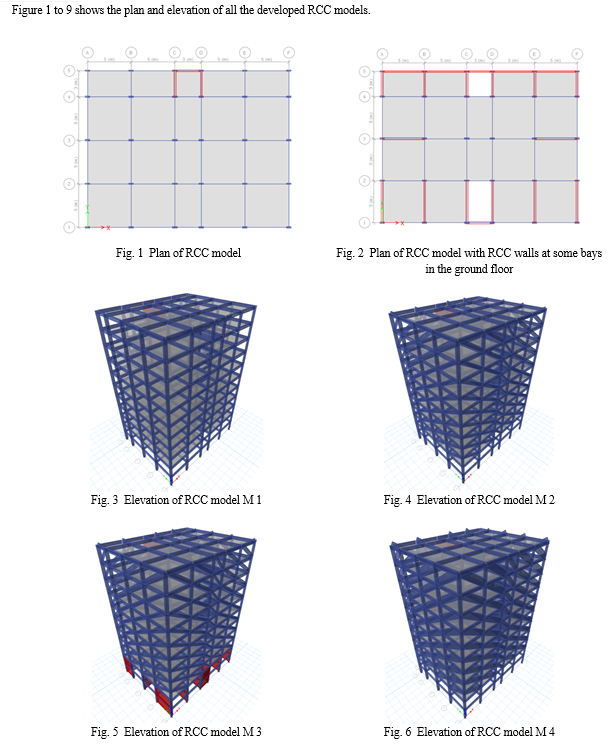
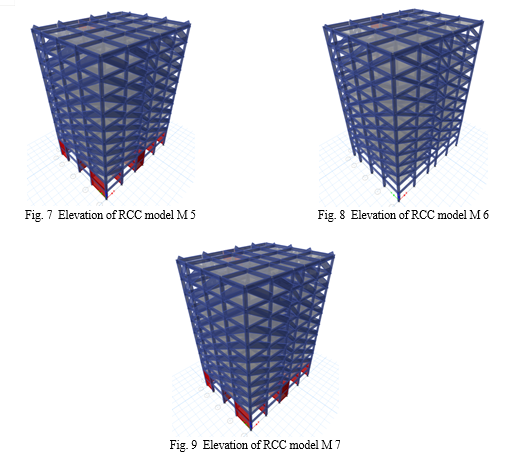
III. SEISMIC ANALYSIS OF RCC MODELS
Using ETABS 2016 software, the developed bare frame and OGS RCC models are subjected to response spectrum analysis as per IS 1893–Part 1 (2016). Seismic parameters viz. storey displacement, drift ratio, stiffness, shear and overturning moments are obtained from the analysis for all the developed models in seismic zone III.
IV. RESULTS AND DISCUSSION
Figures 10 to 19 show the variation of storey displacement, drift ratio, stiffness, shear and overturning moment over the number of stories in both X and Y directions obtained for all the RCC models by response spectrum analysis.

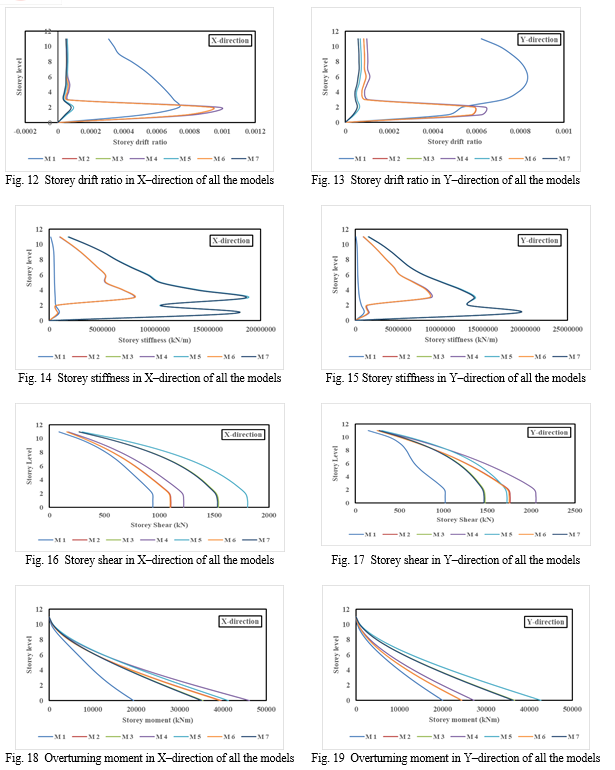
From Figs. 10 and 11 for the seismic zone III, it is observed that all the models exhibit similar kind of variation in storey displacement. However, Storey displacement in Y–direction is found to be more than that of X–direction.
From Figs. 12 and 13 for the seismic zone III, it is observed that all the models exhibit similar kind of variation in storey drift ratio. However, Storey drift ratio in X–direction is found to be more than that of Y–direction.
From Figs. 14 and 15 for the seismic zone III, it is observed that all the models exhibit similar kind of variation in stiffness. However, Storey stiffness in Y–direction is found to be more than that of X–direction.
From Figs. 16 and 17 for the seismic zone III, it is observed that all the models exhibit similar kind of variation in storey shear. However, Storey shear in Y–direction is found to be relatively more than that of X–direction.
From Figs. 18 and 19 for the seismic zone III, it is observed that all the models exhibit similar kind of variation with respect to overturning moment. However, overturning moment in Y–direction is found to be less than that of X–direction.
Figures 20 to 29 show the variation of maximum storey displacement, drift ratio, stiffness, shear and overturning moment for all the RCC frame models by response spectrum analysis.
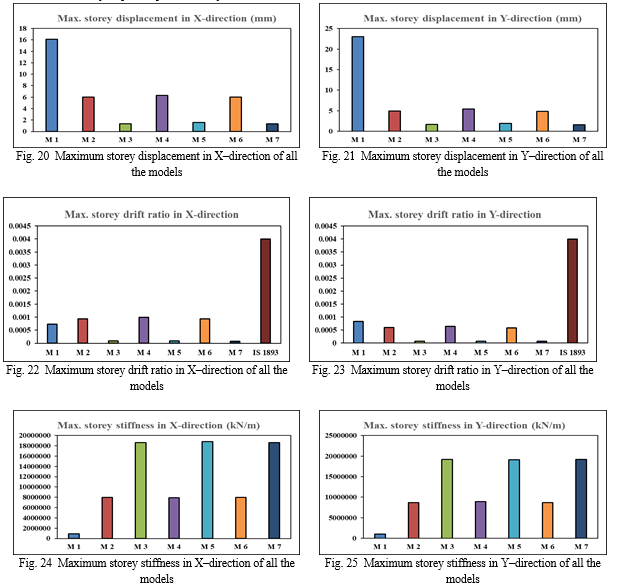
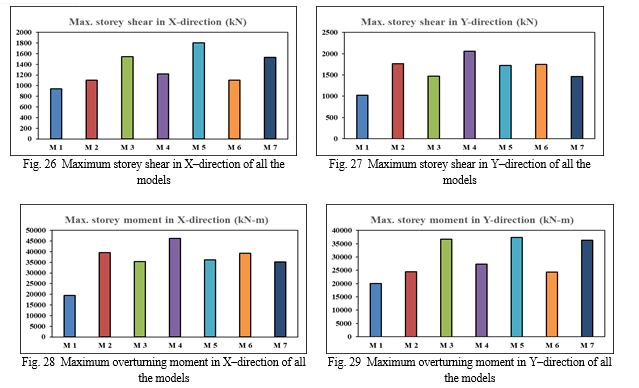
From Figs. 20 and 21, in both X and Y directions, maximum storey displacement is observed in model M 1 (i.e. bare frame). OGS models viz. M 2, M 4 and M 6 which are modelled with infill walls show reduced maximum displacement as compared to Model M 1. However least value of maximum displacement is observed in models M 3, M 5 and M 7 which are provided with RCC walls at ground storey and modelled with infill walls at higher storey.
From Figs. 22 and 23, in both X and Y directions, maximum storey drift ratio value in all the models is within the allowable limit specified in Cl. 7.11.1 of IS 1893–Part 1 (2016). However least value of maximum storey drift ratio is observed in models M 3, M 5 and M 7 which are provided with RCC walls at ground storey and modelled with infill walls at higher storey.
From Figs. 24 and 25, in both X and Y directions, minimum storey stiffness is observed in model M 1 (i.e. bare frame). OGS models viz. M 2, M 4 and M 6 which are modelled with infill walls show high storey stiffness as compared to Model M 1. However highest value of storey stiffness is observed in models M 3, M 5 and M 7 which are provided with RCC walls at ground storey and modelled with infill walls at higher storey. Further, effect of 20% opening in the infill wall was found not to influence the maximum storey stiffness in OGS models and models provided with RCC walls at ground storey.
From Fig. 26, in X direction, as compared to bare frame model (i.e M 1), OGS models viz. M 2, M 4 and M 6 are subjected to high base shear. However highest values of base shear is observed in models M 3, M 5 and M 7 which are provided with RCC walls at ground storey and modelled with infill walls at higher storey. From Fig. 27, in Y direction, as compared to bare frame model (i.e M 1), models M 3, M 5 and M 7 are subjected to high base shear. However highest values of base shear is observed in OGS models viz. M 2, M 4 and M 6. Further, effect of 20% opening in the infill wall was found to reduce the base shear in OGS models and models provided with RCC walls at ground storey. From Fig. 28, in X direction, as compared to bare frame model (i.e M 1), models M 3, M 5 and M 7 are subjected to high over turning moment at the base. However highest values of overturning moment is observed in OGS models viz. M 2, M 4 and M 6. From Fig. 29, in Y direction, as compared to bare frame model (i.e M 1), OGS models viz. M 2, M 4 and M 6 are subjected to overturning moment at the base. However highest values of overturning moment is observed in models M 3, M 5 and M 7 which are provided with RCC walls at ground storey and modelled with infill walls at higher storey. Further, effect of 20% opening in the infill wall was found to reduce the overturning moment in OGS models and models provided with RCC walls at ground storey.
Conclusion
In the present study, seismic performance of Open Ground Storey (OGS) RCC frames is investigated using ETABS software. Bare frame, OGS frame and frames with RCC walls at ground storey are considered and infill walls are modelled as equivalent diagonal strut as per IS 1893–Part 1 (2016) codal provisions and equation given by Paulay and Priestley (1992). Seismic parameters viz. storey displacement, drift ratio, stiffness, shear and overturning moments for the developed RCC models are obtained by response spectrum analysis as per IS 1893–Part 1 (2016) in seismic zone III. The important conclusions drawn from the present study are as follows. 1) Similar variation of storey displacement, drift ratio, stiffness, shear and overturning moments is observed in both X and Y directions for all the models. 2) In both X and Y directions, maximum storey drift ratio value in all the models is within the allowable limit specified in Cl. 7.11.1 of IS 1893–Part 1 (2016). However least value of maximum storey drift ratio is observed in models M 3, M 5 and M 7 which are provided with RCC walls at ground storey and modelled with infill walls at higher storey. 3) In both X and Y directions, maximum storey displacement is observed in model M 1 (i.e. bare frame). OGS models viz. M 2, M 4 and M 6 which are modelled with infill walls show reduced maximum displacement as compared to Model M 1. However least value of maximum displacement is observed in models M 3, M 5 and M 7 which are provided with RCC walls at ground storey and modelled with infill walls at higher storey. 4) In both X and Y directions, minimum storey stiffness is observed in model M 1 (i.e. bare frame). OGS models viz. M 2, M 4 and M 6 which are modelled with infill walls show high storey stiffness as compared to Model M 1. However highest value of storey stiffness is observed in models M 3, M 5 and M 7 which are provided with RCC walls at ground storey and modelled with infill walls at higher storey. Further, effect of 20% opening in the infill wall was found not to influence the maximum storey stiffness in OGS models and models provided with RCC walls at ground storey. 5) In X direction, as compared to bare frame model (i.e M 1), OGS models viz. M 2, M 4 and M 6 are subjected to high base shear. However highest values of base shear is observed in models M 3, M 5 and M 7 which are provided with RCC walls at ground storey and modelled with infill walls at higher storey. Whereas in Y direction, as compared to bare frame model (i.e M 1), models M 3, M 5 and M 7 are subjected to high base shear. However highest values of base shear is observed in OGS models viz. M 2, M 4 and M 6. Further, effect of 20% opening in the infill wall was found to reduce the base shear in OGS models and models provided with RCC walls at ground storey. 6) In X direction, as compared to bare frame model (i.e M 1), models M 3, M 5 and M 7 are subjected to high over turning moment at the base. However highest values of overturning moment is observed in OGS models viz. M 2, M 4 and M 6. Where as in Y direction, as compared to bare frame model (i.e M 1), OGS models viz. M 2, M 4 and M 6 are subjected to overturning moment at the base. However highest values of overturning moment is observed in models M 3, M 5 and M 7 which are provided with RCC walls at ground storey and modelled with infill walls at higher storey. Further, effect of 20% opening in the infill wall was found to reduce the overturning moment in OGS models and models provided with RCC walls at ground storey.
References
[1] Ahiwale D D and Khartode R R (2020), “Evaluation Seismic Response for Soft Storey Building Retrofitted with Infill, Steel Bracing and Shear Wall”, Journal of Structural Technology, Vol. 5, Issue 2, pp. 1–13. [2] Davis R, Krishnan P, Menon D and Prasad M A (2004), “Effect of Infill Stiffness on Seismic Performance of Multi-Storey RC Framed Buildings in India”,13th World Conference on Earthquake Engineering, Vancouver B C, Canada, [3] Deepak and Gupta V (2016), “Seismic Analysis of High–Rise Open Ground Storey Framed Building”, International Journal of Engineering Science and Computing, Vol. 6, Issue 7, pp. 1713–1719. [4] Divya Christabel P M and Nath D R (2015), “Seismic Behaviour of Open Ground Storied Building”, International Journal of Engineering Research and Technology, Vol. 3, Issue 9, pp. 1–13. [5] Mohith Y S and Thejaswini R M (2017), “Behavioural Study of Stiffness in Soft Storey Buildings with Different Infills”, International Research Journal of Engineering and Technology, Vol. 4, Issue 5, pp.1046–1050. [6] Mulgund G V and Kulkarni A B (2011), “Seismic Assessment of RC Frame Buildings with Brick Masonry Infills”, International Journal of Advanced Engineering Sciences and Technologies, Vol. 2, Issue 2, pp. 140–147. [7] Sivakumar N, Karthik S, Thangaraj S, Saravanan S and Shidhardhan C K (2013), “Seismic Vulnerability of Open Ground Floor Columns in Multi Storey Buildings”, International Journal of Scientific Engineering and Research, Vol. 1, Issue 3, pp. 52–58. [8] Tiwari P, Salunke P J and Gore N G (2015), “Earthquake Resistant Design of Open Ground Storey Building”, International Journal of Science Technology and Engineering, Vol. 2, Issue 4, pp. 36–46. [9] Vijayanarayanan A R, Goswami R and Murty C V R (2012), “Special Class of Open Ground Storey RC Buildings Built in India UNSAFE during Earthquakes”, Department of Civil Engineering, Indian Institute of Technology, Madras. [10] IS 875–Part 1 (1987), “Code of Practice for Design Loads (Other than Earthquake) for Buildings and Structures. Part 1 Dead Loads – Unit Weights of Building Materials and Stored Materials”, Bureau of Indian Standards, New Delhi, India. [11] IS 875–Part 2 (1987), “Code of Practice for Design Loads (Other than Earthquake) for Buildings and Structures. Part 2 Imposed Loads”, Bureau of Indian Standards, New Delhi, India. [12] IS 456 (2000), “Code of practice for Plain and Reinforced Concrete”, Bureau of Indian Standards, New Delhi, India. [13] IS 1893–Part 1 (2016), “Criteria for Earthquake Resistant Design of Structures. Part 1 General Provisions and Buildings”, Bureau of Indian Standards, New Delhi, India.
Copyright
Copyright © 2022 Ramesh M, Dr. Chidananda G. This is an open access article distributed under the Creative Commons Attribution License, which permits unrestricted use, distribution, and reproduction in any medium, provided the original work is properly cited.

Download Paper
Paper Id : IJRASET47006
Publish Date : 2022-10-07
ISSN : 2321-9653
Publisher Name : IJRASET
DOI Link : Click Here
 Submit Paper Online
Submit Paper Online

